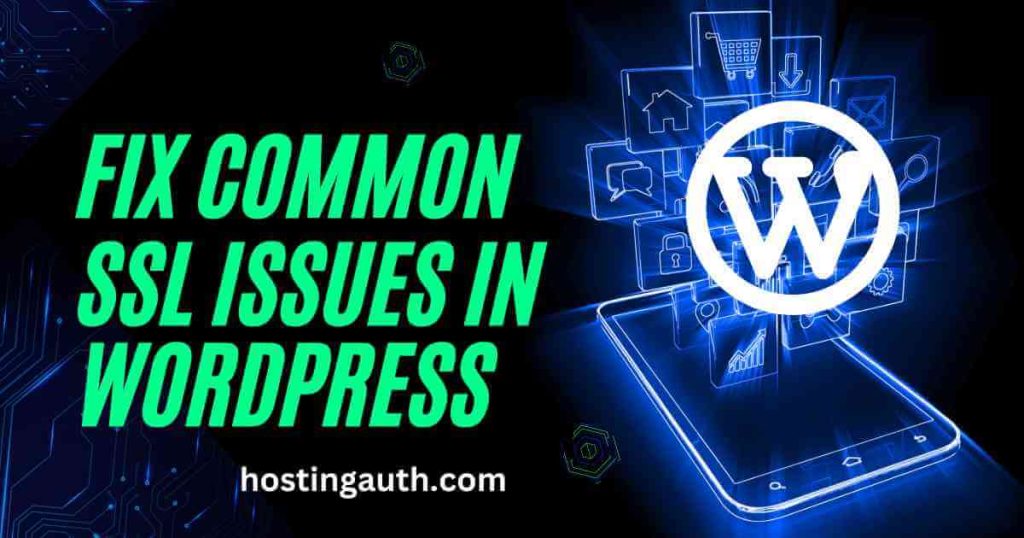Securing your WordPress site with SSL is crucial in today’s online landscape, where cyber threats are constantly looming. However, issues with SSL certificates and HTTPS settings can sometimes plague website owners, leaving their site vulnerable to attacks and showing up as “Not Secure” in browsers. In this blog post, we will delve into common SSL issues in WordPress and provide you with troubleshooting tips to ensure that your site is well-protected and displaying that coveted green padlock symbol.
Troubleshooting SSL Errors in WordPress
Are you encountering SSL errors on your WordPress site? Here’s how to identify and troubleshoot common issues:
Identifying common SSL errors on your WordPress site
- Look for browser warnings about insecure connections or mixed content.
- Check for SSL certificate validity and expiration.
- Inspect your website’s source code for HTTP links instead of HTTPS.
Using tools like SSL Checker to diagnose SSL issues
Utilize online tools like SSL Checker to scan your site for SSL/TLS issues. These tools can help identify SSL certificate problems, chain issues, and other SSL-related errors.
Securing Your WordPress Site with SSL
Securing your WordPress site with an SSL certificate is essential for ensuring the safety and confidentiality of your website’s data. Here are some steps to implement SSL on your WordPress site:
Implementing SSL Certificates
First, obtain an SSL certificate from a trusted Certificate Authority. This certificate will encrypt the data exchanged between your website and its visitors, making it secure from cyber threats.
Configuring HTTPS Settings in WordPress
Once you have acquired the SSL certificate, configure the HTTPS settings in your WordPress dashboard. Go to Settings > General and update the WordPress Address (URL) and Site Address (URL) fields with HTTPS URLs. This ensures that your site is served over a secure connection.
By following these steps, you can enhance the security of your WordPress site and build trust with your visitors. Make sure to regularly update your SSL certificate and monitor for any potential issues to maintain a secure online presence.
Common SSL Problems on WordPress Sites
Mixed Content Warnings on WordPress Sites
One common issue that many WordPress site owners face when implementing SSL is mixed content warnings. These warnings occur when your site contains a mix of secure (HTTPS) and non-secure (HTTP) elements, which can lead to security vulnerabilities.
Potential Causes of SSL Handshake Failures
SSL handshake failures can also pose challenges for WordPress site owners. These failures occur when the browser and the server are unable to establish a secure connection, often due to mismatched SSL certificate settings or incompatible protocols.
Solving SSL Issues on Your Website
SSL errors can be frustrating, but with the right troubleshooting steps, you can quickly fix them and ensure your WordPress site is secure. Here are some tips to help you resolve SSL issues:
1. Check your SSL certificate validity
Make sure your SSL certificate is valid and has not expired. If it has expired, renew it with your SSL provider to restore secure connections.
2. Verify SSL installation
Double-check that your SSL certificate is properly installed on your server. Contact your hosting provider or SSL issuer for assistance if needed.
3. Fix mixed content warnings
Ensure that all elements on your site, such as images, scripts, and stylesheets, are loaded over HTTPS to avoid mixed content warnings. Use a plugin or manual method to update URLs.
4. Debug SSL handshake failures
If you encounter SSL handshake failures, check your server logs for error messages. Address any server configuration issues or conflicts that may be causing the problem.
5. Update WordPress settings
Go to the WordPress settings and ensure that the WordPress Address (URL) and Site Address (URL) fields include “https://” to reflect the use of SSL on your site.
6. Test your SSL implementation
Use tools like SSL Checker to scan your site for SSL issues and validate the SSL configuration. This will help you pinpoint any remaining issues that need to be addressed.
By following these steps and best practices, you can effectively troubleshoot and fix SSL issues on your WordPress site, ensuring that your site is secure and trusted by visitors.
Fixing SSL Not Working on WordPress
SSL not working on your WordPress site can be a frustrating issue, but it’s important to address it promptly to ensure the security of your site. Here are some steps to help you troubleshoot and fix SSL problems on your WordPress site:
1. Check SSL Certificate Installation
- Verify that your SSL certificate is properly installed on your server.
- Make sure the certificate is issued by a trusted Certificate Authority (CA).
2. Update Your Site URL
- Go to Settings > General in your WordPress dashboard.
- Ensure that your WordPress Address (URL) and Site Address (URL) fields start with “https://”.
3. Clear Your Browser Cache
- Clear your browser cache and cookies to ensure that you are loading the latest version of your site.
4. Check Your Content for Mixed Content
- Use a tool like Why No Padlock to identify any mixed content issues on your site.
- Update all URLs in your content to use “https://” instead of “http://”.
5. Update Your .htaccess File
- Edit your site’s .htaccess file to redirect all traffic to the HTTPS version of your site.
- Add the following lines to your .htaccess file:
RewriteEngine On RewriteCond %{HTTPS} off RewriteRule ^ https://%{HTTP_HOST}%{REQUEST_URI} [L,R=301]
By following these steps, you can resolve SSL not working issues on your WordPress site and ensure that your site is secure and properly encrypted.
Resolving HTTPS Problems on Your Site
Having HTTPS is crucial for ensuring the security of your WordPress site. However, issues may arise that hinder the proper implementation of HTTPS. Below are some strategies to help you resolve HTTPS problems on your site:
Identifying HTTPS Problems
- Check for mixed content warnings: Mixed content occurs when your site’s HTTPS is compromised by the presence of non-secure (HTTP) elements.
- Verify SSL certificate validity: Make sure your SSL certificate is up to date and properly installed.
- Review HTTPS settings: Ensure that your WordPress site is configured to use HTTPS for all URLs.
Strategies for Proper HTTPS Implementation
- Update internal links: Make sure all internal links on your site use the HTTPS protocol.
- Use HTTPS-compatible plugins: Avoid using plugins that may conflict with HTTPS settings on your site.
- Utilize HTTPS best practices: Enforce HTTPS site-wide, including secure cookies and HSTS (HTTP Strict Transport Security) headers.
By addressing HTTPS problems and implementing these strategies, you can maintain a secure environment for your WordPress site and ensure the protection of sensitive information transmitted over the web.
Ensuring Your WordPress Site is Secure with SSL
Securing your WordPress site with SSL is essential for protecting sensitive data and building trust with your visitors. Here are some tips to ensure your site is secure:
1. Implement SSL Certificates
First and foremost, you need to obtain and install an SSL certificate on your server. This will encrypt data transmitted between your site and your visitors, making it secure from potential threats.
2. Configure HTTPS Settings
Once you have installed an SSL certificate, you need to configure your HTTPS settings in WordPress. Make sure that all URLs on your site are using the HTTPS protocol to ensure a secure connection.
3. Regularly Update Plugins and Themes
Keeping your WordPress plugins and themes up to date is crucial for maintaining security. Outdated software can create vulnerabilities that hackers can exploit, so make sure to regularly update all components of your site.
4. Use Secure Passwords
Always use strong, unique passwords for your WordPress admin and hosting accounts. This will help prevent unauthorized access to your site and protect it from potential security threats.
5. Enable Two-Factor Authentication
Implementing two-factor authentication adds an extra layer of security to your WordPress site. This requires users to provide an additional piece of information beyond their password, making it harder for unauthorized users to gain access.
By following these tips and best practices, you can ensure that your WordPress site is secure with SSL and protect your visitors’ data from potential threats.
Frequently Asked Questions
1. What are some common SSL issues in WordPress sites?
Some common SSL issues in WordPress sites include mixed content warnings, SSL handshake failures, and HTTPS problems.
2. How can I troubleshoot SSL errors on my WordPress site?
You can use tools like SSL Checker to identify SSL errors on your WordPress site and take necessary steps to fix them.
3. How do I ensure proper HTTPS implementation on my WordPress site?
To ensure proper HTTPS implementation, make sure to configure HTTPS settings in WordPress and install SSL certificates on your site.
4. What should I do if SSL is not working on my WordPress site?
If SSL is not working on your WordPress site, you can troubleshoot the issue by checking your SSL setup and implementing necessary fixes.
5. Why is it important to secure my WordPress site with SSL?
Securing your WordPress site with SSL is crucial for protecting sensitive information and maintaining trust with your visitors.
Conclusion
In conclusion, resolving SSL issues on your WordPress site is crucial for enhancing security and ensuring a trustworthy user experience. By identifying common SSL errors, securing your site with SSL certificates, and troubleshooting any HTTPS problems, you can maintain a secure and reliable online presence. Remember to regularly check for any SSL issues and implement best practices to keep your WordPress site secure with SSL.

